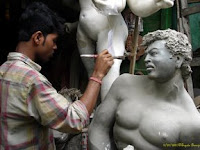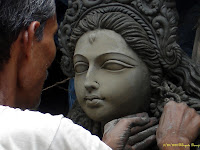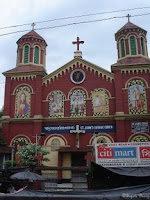"We're at the bus stand waiting for the bus," I furiously typed the message on my mobile phone, "As soon as it arrives we'll leave without you." After sending it to Sushil, I turned my attention to my breakfast once more.
I, Amit and Shreevallabh were having our breakfast at the Sangeetha Restaurant near the Adyar crossing in Chennai. It was the first Saturday after joining our first job, and we intended to celebrate the completion of our first week as IT professionals with a trip to Mahabalipuram. Six of us were going, including Abhijit and Samiraj, who would be joining us at the bus stand, and Sushil. The only problem was that Sushil had woken up just five minutes ago. To ensure that he did not fall asleep again and reached us as fast as he could, we took turns calling him and SMSing him over our breakfast, all the while lying blatantly about our progress. As a result, he joined us soon after we reached the bus stand. Abhijit and Samiraj were already there, so we proceeded to board a bus and head towards Mahabalipuram.
Mahabalipuram is only 60 km from Chennai, and it wasn't long before we reached there. The journey probably also seemed short and uneventful as we were all sleeping most of the time. On reaching there, we first went to a shop so that Sushil, who had not had any breakfast, could eat something. Then we went to see the five monolithic "
Rathas" or small temple-prototypes built by the Pallava rulers largely between the 7th and the 9th century.

After seeing the
Rathas we went to see the
Mahishasurmardini cave temple and the lighthouse. There are two lighthouses: one medieval one that used a fire for signaling, and a modern one with a powerful electric beam. From top of the old lighthouse we could see the shore stretched out in front of us beyond the cliffs and boulders that lined the terrain. On looking out far towards the horizon, one could just make out the nuclear power plant at Kalpakkam. Climbing atop the modern lighthouse is not allowed.
It was quite hot, and after having a Kakri (a serpentine cucumber-like fruit) each and a hearty brawl with the old lady selling them, we proceeded towards the other places to be seen. Men selling tiny statues had been pestering us, and one had almost roped in Sushil by reducing the price of his ware from Rs.50 to Rs.15, but finally we decided that even Rs.15 was too high and left.
 The next place was full of some hillocks and cave-like rock formations. The main attraction here is Krishna’s Butterball, which is a huge round rock perched precariously atop an inclined rocky hillside. I gave my camera to another tourist and all six of us climbed up the hillock to go and pose under the round rock. It was fun, but I must admit that it was a bit scary too. If suddenly that rock decided to roll down, we would become pancakes (like they show in Tom & Jerry). However, the rock stayed exactly as it had stayed for thousands of years and we came down safe and sound again. We were unlucky about the camera though --- when the man returned it to me I found the film compartment door slightly ajar. Our last photo and the next couple of frames were ruined.
The next place was full of some hillocks and cave-like rock formations. The main attraction here is Krishna’s Butterball, which is a huge round rock perched precariously atop an inclined rocky hillside. I gave my camera to another tourist and all six of us climbed up the hillock to go and pose under the round rock. It was fun, but I must admit that it was a bit scary too. If suddenly that rock decided to roll down, we would become pancakes (like they show in Tom & Jerry). However, the rock stayed exactly as it had stayed for thousands of years and we came down safe and sound again. We were unlucky about the camera though --- when the man returned it to me I found the film compartment door slightly ajar. Our last photo and the next couple of frames were ruined.
Then we went to see the carved rock called “Arjuna’s Penance”. It is a large rock lying on the roadside with a lot of figures sculpted on it. It shows Arjuna, a hero from the epic Mahabharata during his penance. It was lunch time and we were feeling as if we were doing penance ourselves, so we went to have lunch at a typical Tamil restaurant.
The food was of course typically Tamil. There was rice and five different kinds of sambhar, chutney and papad. There was also curd, buttermilk and a sweet, and some things that I have forgotten. The rice was served on banana leaves. The taste was good, but then, you don’t bother about the taste when you are eating five kinds of sambhar in one meal.
After lunch we walked to the shore Temple. This is the only historical temple in Mahabalipuram that is not monolithic. It is set directly on the beach, and is in a bad shape due to the corrosion caused by the sea water, wind and sand. Luckily it was not damaged by the
Tsunami of December 2004. Our legs were very tired by this time, and we just rested there and chatted for a long, long time. The wind was intoxicating, and due to a full stomach, we just felt like sleeping. However, we had another important activity to finish: something for which we had been carrying our clothes since the morning.
The beach was neither deserted, nor too crowded. It was cleaner than the beaches of Chennai. The day had turned cloudy when we reached there. We chose a dry spot near the water and got into our bathing clothes. Then we went for a dip in the sea. None of us knew swimming properly, so we bathed in waist deep water. It was my first (and till date only) sea bathing experience and I can’t say I enjoyed it very much. Firstly the salt water kept getting into my mouth. Secondly the salt water kept getting into my eyes and it hurt a lot. Thirdly the water also carried sand into my mouth and eyes. And most importantly, there were quite strong waves that kept coming and knocking me head over heels. Since I don’t know swimming, and I had left my glasses on the shore, it was scaring me. After completing our bath, we got dressed on the beach. This was a BIG mistake. We should have looked for some rocky place first. I don’t know about others, but the sand on the beach got on my wet feet, and then from there it reached each and every corner of my body inside my clothing, and I felt as if I was wearing a sandpaper suit. I was rubbed raw by the time I reached home. That was not the end of our miseries. Washing those clothes proved to be a bigger problem than we had imagined, and I and Amit took turns rinsing them again and again to wash away the grains of sand.
Anyway, after we had dressed, Shreevallabh took a ride on a horse, and then we walked among the souvenir shops. There were stone figures and beautiful sea shells. The prices were exorbitant due to the presence of foreign tourists. We bought a few small items and came to the bus stand. There we visited a temple (a functional one, not a historical ruin) and then boarded a bus for Chennai. The return journey was bad. I slept for some time and when I woke up I found that the bus was so crowded that there wasn’t place even to stand. When our stop came we somehow squeezed out, and went home tired.
Thus our first trip from Chennai was a grand success and it went a long way in strengthening the bond that the six of us share to this day. Before the trip we were a group of six strangers each of who knew at most another member in the group. After the trip we were six friends who stayed together in most activities most of the time throughout our stay in Chennai. The other trip that we had planned during our two month stay didn’t work out properly, but I’ll tell that story some other day.
(Photos courtesy Wikipedia. The photos that I took are not with me currently.)



 That's all for now I'm afraid. However, if we go by Anyesha's calculation, this post is about 4325 words long. I think that's good enough considering my busy schedule.
That's all for now I'm afraid. However, if we go by Anyesha's calculation, this post is about 4325 words long. I think that's good enough considering my busy schedule.





















